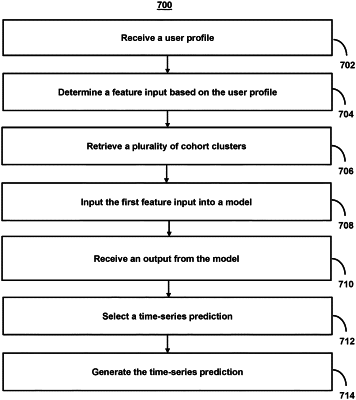| CPC G06N 20/00 (2019.01) | 20 Claims |

|
1. A system for using cohort-based predictions in clustered time-series data in order to detect rate-of-change events, the system comprising:
one or more processors; and
a non-transitory, computer-readable medium comprising instructions recorded thereon that when executed by the one or more processors cause operations comprising:
generating historical time-series training data that indicates historic rates-of-change over given time periods;
receiving, at a user interface of a client portal, a request for a time-series prediction;
receiving a first user profile, wherein the user profile comprises a current state characteristic;
determining a subset of state characteristics for generating a first feature input based on the current state characteristic;
populating the first user profile with the subset of state characteristics;
in response to receiving the first user profile, determining a first feature input based on the subset of state characteristics;
retrieving a plurality of cohort clusters, wherein the plurality of cohort clusters is generated by a first artificial intelligence model that is trained to cluster a plurality of separate time-series data streams into the plurality of cohort clusters through unsupervised hierarchical clustering;
inputting the first feature input into a second artificial intelligence model, wherein the second artificial intelligence model is trained to select a subset of the plurality of cohort clusters from the plurality of cohort clusters based on the first feature input, and wherein each cohort cluster of the plurality of cohort clusters corresponds to a respective cohort of users having current state characteristics, and wherein training the second artificial intelligence model comprises training a convolutional neural network using unsupervised learning on the historical time-series training data;
receiving an output from the second artificial intelligence model;
selecting, based on the output, a time-series prediction from a plurality of time-series predictions, wherein each of the plurality of time-series predictions comprises a respective predicted event, and wherein each cohort cluster of the subset of the plurality of cohort clusters corresponds to a respective time-series prediction of the plurality of time-series predictions; and
generating, at the user interface of the client portal, the time-series prediction comprising a rate-of-change predicted event.
|